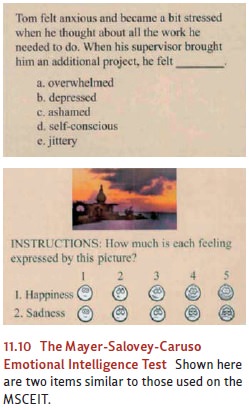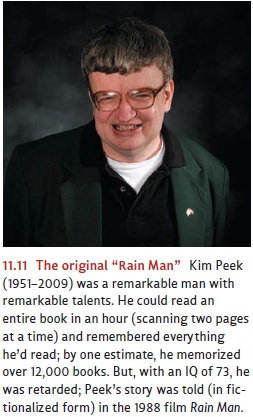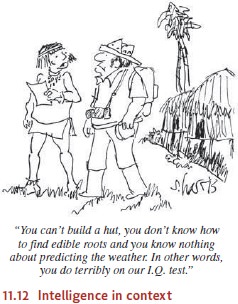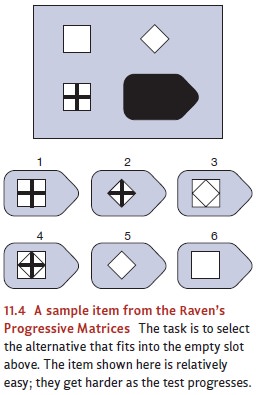Chapter: Psychology: Intelligence
Intelligence Beyond the IQ Test
INTELLIGENCE BEYOND
THE IQ
TEST
We’ve
now made good progress in filling in our portrait of intelligence. We know that
we can speak of intelligence in general; the psychometric data tell us that. We
also know how to distinguish some more specific forms of intelligence
(linguistic, quantitative, spatial; fluid, crystallized). And, finally, we know
some of the elements that give someone a higher or lower g—namely, mental speed, working memory capacity, and executive
control.
We
might still ask, though, whether there are aspects of intelligence not included
in this portrait—aspects that are somehow separate from the capacities we
measure with our conventional intelligence tests. For example, you probably
know people who are “street-smart” or “savvy,” but not “school-smart.” Such
people may lack the sort of ana-lytic skill required for strong performance in
the classroom, but they’re sophisticated and astute in dealing with the
practical world. Likewise, what about social competence—the ability to persuade
others and to judge their moods and desires? Shrewd salespeople have this
ability, as do successful politicians, quite independent of whether they have
high or low IQ scores.
A
number of studies have explored these other nonacademic forms of intelligence.
For example, one study focused on gamblers who had enormous experience in
betting on horse races and asked them to predict the outcomes and payoffs in
several upcom-ing races. This is a tricky mental task that involves highly
complex reasoning. Factors like track records, jockeys, and track conditions
all have to be remembered and weighed against one another. On the face of it,
the ability to perform such mental calculations seems to be part of what
intelligence tests should measure. But the results proved otherwise; the
gamblers’ success turned out to be completely unrelated to their IQs (Ceci
& Liker, 1986). These findings and others have persuaded researchers that
we need to broaden our conception of intelligence and consider forms of
intelligence that aren’t measured by the IQ test.
Practical Intelligence
One
prominent investigator, Robert Sternberg, has argued that we need to
distinguish several types of intelligence. One type, analytic intelligence, is measured by standard intelligence tests.
A different type is practical
intelligence, needed for skilled reasoning in the day-to-day world
(Sternberg, 1985; also see Henry, Sternberg, & Grigorenko, 2005; Sternberg
& Kaufman, 1998; Sternberg, R. Wagner, Williams, & Horvath, 1995; R.
Wagner, 2000; Figure 11.9).
In
one of Sternberg’s studies, business executives read descriptions of scenarios
involving problems similar to those they faced in their professional work. The

executives
also considered various solutions for each problem and rated them on a scale
from 1 (poor solution) to 7 (excellent solution). These ratings were then used
to assess how much tacit knowledge
each of the executives had—that is, practical know-how gleaned from their
everyday experience. The data showed that this measure of tacit knowledge was
predictive of job performance (and so was correlated with on-the-job
performance ratings as well as salary). Crucially, though, measures of tacit
knowledge weren’t correlated with IQ—and so are plainly assessing something
separate from the sorts of “intelligence” relevant to the IQ test (Sternberg
& Wagner, 1993; R. Wagner, 1987; R. Wagner & Sternberg, 1987).
Other
research, however, has challenged the claim that practical intelligence is
independent of analytic intelligence. In one study, for example, measures of
practical intel-ligence were correlated with measures of g (Cianciolo et al., 2006; also see N. Brody, 2003; Gottfredson,
2003a, 2003b; Sternberg, 2003). Even so, many researchers believe that
prac-tical intelligence is different enough from analytic intelligence to
justify separating them in our overall theorizing about people’s different
levels and types of intellectual
ability.
Emotional Intelligence
A
different effort toward broadening the concept of intelligence involves claims
about emotional intelligence—the
ability to understand one’s own emotions and others’,and also the ability to
control one’s emotions when appropriate. The term emotionalintelligence might seem an oxymoron, based on the widely
held view that emotions often undermine our
ability to think clearly and so work against our ability to reason
intelli-gently. Many psychologists, however, reject this claim. They argue that
emotion plays an important role in guiding our problem solving and decision
making (see, for example, Bechara, H. Damasio, & A. Damasio, 2000; A.
Damasio, 1994); emotion also plays a role in guiding our attention and shaping
what we remember (Reisberg & Hertel, 2004). In these ways, emotion and
cognition interact and enrich each other in impor-tant ways.
One
theory suggests that emotional intelligence actually has four parts. First,
there’s an ability to perceive emotions accurately—so that, for example, you
can tell when a friend is tense or when someone is becoming angry. Second,
there’s an ability to use emotions to facilitate thinking and reasoning,
including a capacity to rely on your “gut feelings” in guiding your own
decisions. Third, there’s an ability to understand emo-tions, including the use
of language to describe emotions, so that you’re alert to how a friend will act
when she’s sad or to how fear can alter someone’s perspective; also included
here is the ability to talk about emotions—to convey to others how you’re
feel-ing and to understand what they tell you about their feelings. Finally,
there’s an ability to manage emotions in oneself and others; this includes the
ability to abide by your cul-ture’s rules for “displaying” emotions as well as
the ability to regulate your own emo-tions.
Researchers
have developed various measures of emotional intelligence, including the
Mayer-Salovey-Caruso Emotional Intelligence Test (MSCEIT; Bracket & Mayer,
2003; Mayer, Salovey, Caruso, & Sitarenios, 2003; Figure 11.10). This
measure appears to have predictive validity so that, for example, people who
score higher on the MSCEIT seem to be more successful in social settings. They
have fewer conflicts with their peers, are judged to create a more positive
atmosphere in the workplace, are more tolerant of stress, and are judged to
have more leadership potential (Lopes, Salovey, Côté, & Beers, 2005; Grewal
& Salovey, 2005). Likewise, college students with higher

MSCEIT
scores are rated by their friends as more caring and more supportive. They are
also less likely to experience conflict with their peers (Brackett & Mayer,
2003; Mayer et al., 2008a).
The
idea of emotional intelligence has received much attention in the media and
popular literature; as a result, various claims have been offered in the media
that are not supported by evidence. (For a glimpse of the relationship between
the science and the mythology here, and some concerns about the idea of
emotional intelligence, see Matthews, Zeidner, & Roberts, 2003, 2005.)
Still, emotional intelligence does seem to matter for many aspects of everyday
functioning, it can be measured, and it is one more way that people differ from
one another in their broad intellectual competence.
The Theory of Multiple Intelligences
It
seems that our measures of g—so-called
general intelligence—may not provide as complete a measurement as we thought.
The capacities measured by g are
surely important, but so are other aspects of intelligence—including practical
intelligence, emotional intelligence, and, according to some authors, social intelligence (see, for exam-ple,
Kihlstrom & Cantor, 2000). Other authors would make this list even longer:
In his theory of multiple intelligences,
Howard Gardner argued for several further types of intelligence (Gardner, 1983,
1998): Three of these are incorporated in most standard intelligence tests: linguistic intelligence,
logical-mathematical intelligence, and spatialintelligence.
But Gardner also argued that we should acknowledge musical intelligence, bodily-kinesthetic intelligence (the ability
to learn and create complex patterns of move-ment), interpersonal intelligence (the ability to understand other
people), intrapersonalintelligence (the
ability to understand ourselves), and
naturalistic intelligence (the abilityto understand patterns in nature).
Gardner
based his argument on several lines of evidence, including studies of patients
with brain lesions that devastate some abilities while sparing others. Thus,
certain lesions will make a person unable to recognize drawings (a disruption
of spatial intelligence), while others will make him unable to perform a
sequence of movements (bodily-kinesthetic intelligence) or will devastate
musical ability (musical intelligence). Gardner concluded from these cases that
each of these capacities is served by a separate part of the brain (and so is
disrupted when that part of the brain is damaged), and therefore each is
distinct from the others.
Another
argument for Gardner’s theory comes from the study of people with so-called savant syndrome. These individuals have
a single extraordinary talent, even though they’re otherwise developmentally
disabled (either autistic or mentally retarded) to a profound degree. Some
display unusual artistic talent. Others are “cal-endar calculators,” able to
answer immediately (and correctly!) when asked questions such as “What day of
the week was March 17 in the year 1682?”. Still oth-ers have unusual mechanical
talents or remarkable musical skills—for example, they can effortlessly
memorize lengthy and complex musical works (A. Hill, 1978; L .K .Miller, 1999).
Gardner’s
claims have been controversial, partly because some of the data he cites are
open to other interpretations (see, for example, Cowan & Carney, 2006; L.
K. Miller, 1999; Nettelbeck & Young, 1996; Thioux, Stark, Klaiman, &
Schultz, 2006). In addition, evidence indicates that several of the forms of
“intelligence” Gardner describes are inter-correlated—and so if someone has
what Gardner calls linguistic intelligence, they’re also likely to have
logical-mathematical, spatial, interpersonal, and naturalistic intelligence.
This obviously challenges Gardner’s assertion that these are separate and
independent capacities (Visser, Ashton & Vernon, 2006).

There’s
also room for disagreement about Gardner’s basic conceptualization. Without
question, some individuals—whether savants or otherwise—have special talents; and
these talents are impressive (Figure 11.11). But is it appropriate to think of
these talents as forms of intelligence? Or might we be better served by a
distinction between intelligence and talent? It does seem peculiar to use the
same term, intelligence, to describe
both the capacity that Albert Einstein displayed in developing his theories and
the capacity that Peyton Manning displays on the football field. Similarly, we
might celebrate the vocal tal-ent of Beyoncé Knowles; but is hers the same type
of talent—and therefore sensibly described by the same term, intelligence—that a skilled debater
relies on in rapidly think-ing through the implications of an argument?
Whatever
the ultimate verdict on Gardner’s theory, he has undoubtedly done us a valu-able
service by drawing our attention to a set of abilities that are often ignored
and under-valued. Gardner is surely correct in noting that we tend to focus too
much on the skills and capacities that help people succeed in school, and do
too little to celebrate the talents dis-played by an artist at her canvas, a
skilled dancer in the ballet, or an empathetic clergyman in a hospital room.
Whether these other abilities should be counted as forms of intelli-gence or
not, they’re surely talents to be highly esteemed and, as much as possible,
nur-tured and developed.
The Cultural Context of Intelligence
Yet
another—and perhaps deeper—challenge to our intelligence tests, and a powerful
reason to think beyond the IQ scores, comes from a different source: the
question of whether our tests truly measure intelligence, or whether they
merely measure what’s called intelligence
in our culture.
Different
cultures certainly have different ideas about what intelligence is. For
exam-ple, some parts of the intelligence test put a premium on quick and
decisive responses, but not all cultures share our Western preoccupation with
speed. Indians (of southern Asia) and Native Americans, for example, place a
higher value on being deliberate; in effect, they’d rather be right than quick.
They also prefer to qualify, or to say “I don’t know” or “I’m not sure,” unless
they’re absolutely certain of their answer. Such delib-eration and hedging
would hurt their test scores on many intelligence tests because it’s often a
good idea to guess whenever you’re not sure about the answer (Sinha, 1983;
Triandis, 1989). Similarly, Taiwanese Chinese place a high priority on how they
relate to others; this will, in some circumstances, lead them not to show their
intelligence, thus undermining our standardized assessment (Yang &
Sternberg, 1997; also Nisbett, 2003; for other cultural differences in how
intelligence is defined, see Serpell, 2000; Sternberg, 2004).

These
cultural differences guarantee that an intelligence test that seems appropriate
in one cultural setting may be inappropriate in other cultural settings (Figure
11.12). Moreover, the specific procedure we need for measuring intelligence
also depends on the cultural setting. This is because people in many countries
fail to solve problems that are presented abstractly or that lack a familiar
context, but they do perfectly well with identical problems presented in more
meaningful ways. For example, consider the response of an unschooled Russian
peasant who was asked, “From Shakhimardan to Vuadil it takes three hours on
foot, while to Fergana it is six hours. How much time does it take to go on
foot from Vuadil to Fergana?” The reply was “No, it’s six hours from Vuadil to
Shakhimardan. You’re wrong. . . . It’s far and you wouldn’t get there in three
hours” (Luria, 1976). If this had been a question on a standard intelligence
test, the peasant would have scored poorly—not because he was unintelligent,
but because he did not regard the question as a test of arithmetical reasoning.
It turned out that he was quite able to perform the relevant calculation but
could not accept the form in which the question was presented.
In
light of these concerns, we might well ask whether it’s possible to measure
intel-ligence in a way that’s fair to all cultures and biased against none. The
Raven’s Progressive Matrices (Figure 11.4) are often claimed to be fair to all
groups because the test is nonverbal and doesn’t rely on any sort of specific
prior knowledge. But the very idea of organizing items in rows and columns—an
idea that’s essential for this test—is unfamiliar in some settings, and this
puts test takers in those settings at a disadvantage with this form of testing.

To
put this worry somewhat differently, we could (if we wished) use a standard
intel-ligence test to assess people living in, say, rural Zambia, and the test
results probably would allow us to predict whether the Zambians will do well in
Western schools or in a Western-style workplace. But this form of testing would
tell us nothing about whether these Zambians have the intellectual skills they
need to flourish in their own cultural setting. Just as bad, our test would
probably give us an absurd understatement of the Zambians’ intellectual
competence because our test is simply in the wrong form to reveal that
competence.
Against
this backdrop, it’s important to emphasize that some mental capacities can be
found in all cultures—including (as just one example) the core knowledge needed
to understand some aspects of mathematics (see, for example, Dehaene, Izard,
Pica, & Spelke, 2006). But it’s also clear that cultures differ not only in
the skills they need and value but also in how they respond to our Westernized
test procedures. As a result, we need to be extremely careful in how we
interpret or use our measures of intelligence. Intelligence tests do capture
important aspects of intellectual functioning, but they don’t capture all
aspects or all abilities, and the meaning and utility of the tests has to be
understood in the appropriate cultural context. (For further discussion, see
Greenfield, 1997; Serpell, 2000; Sternberg, 2004.)
Related Topics